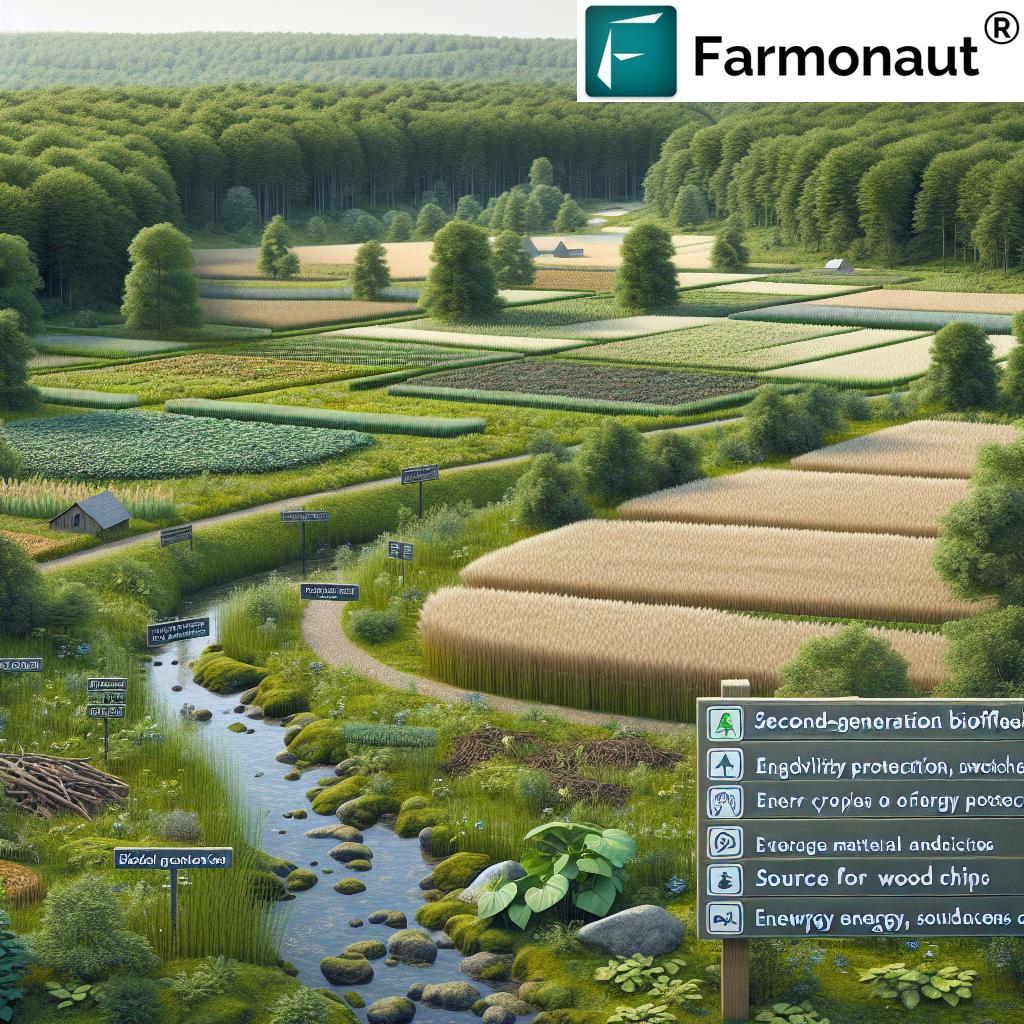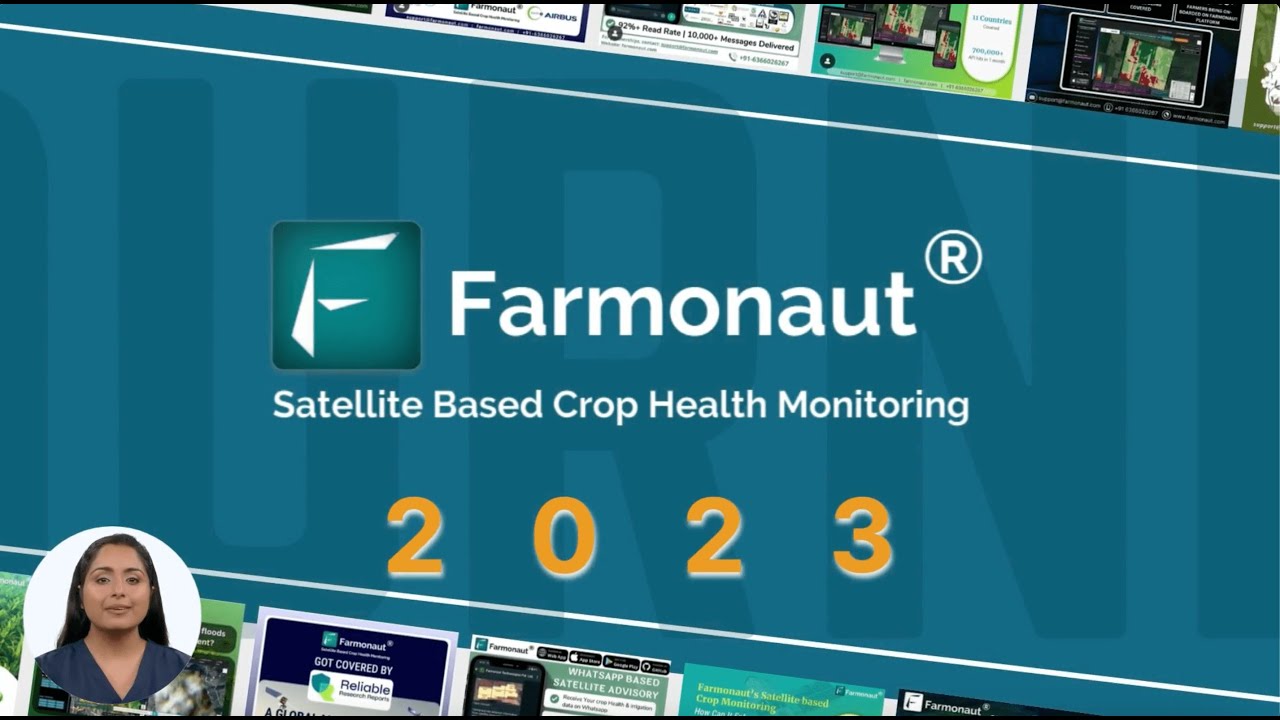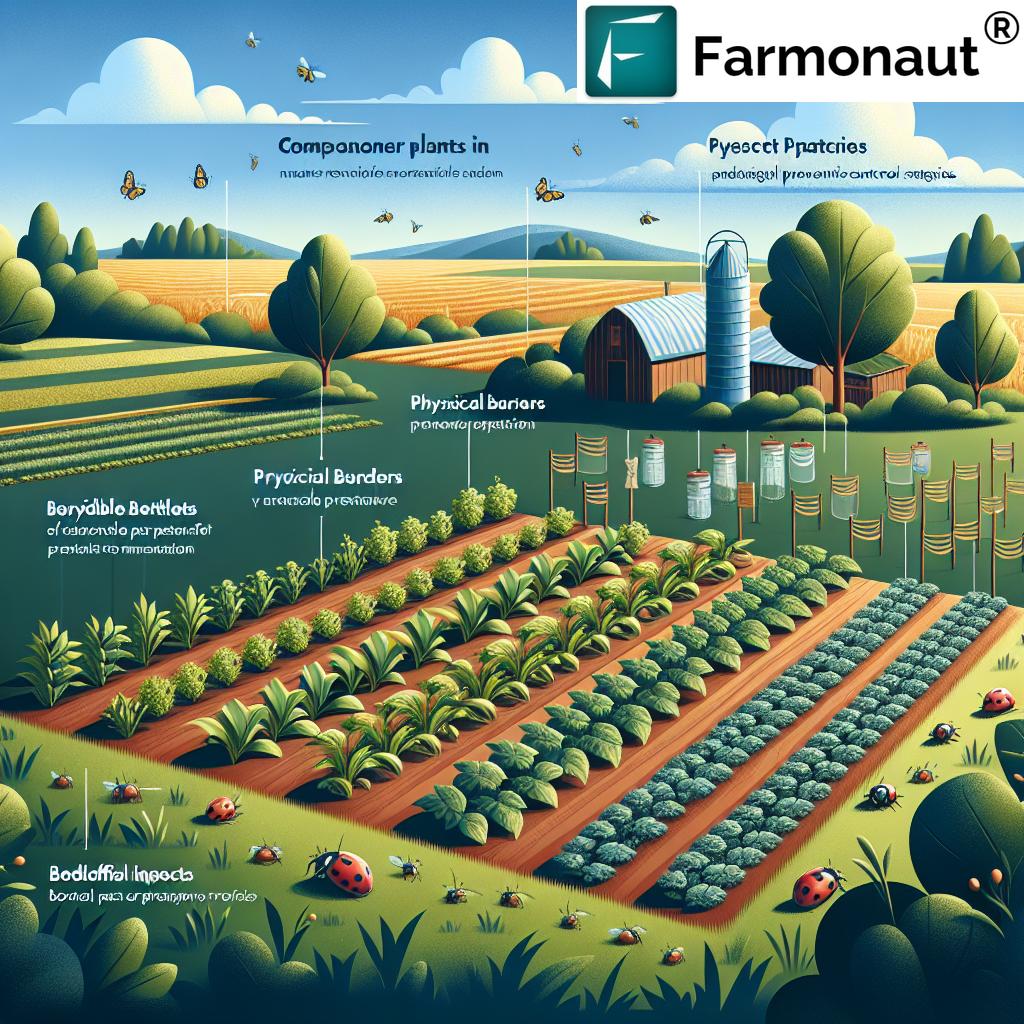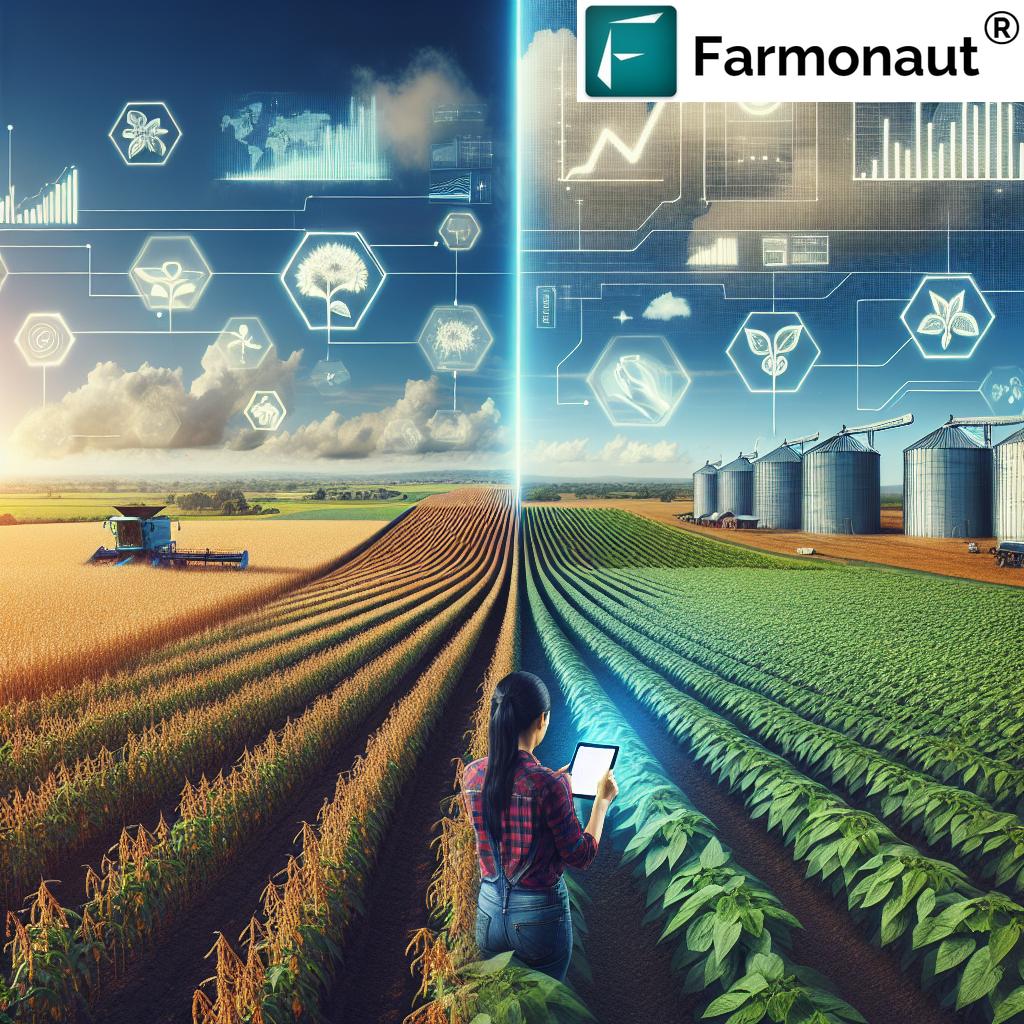Biofuels: 7 Powerful Ways to Boost Sustainable Agriculture
“Globally, sustainable biofuel production could supply 27% of world transport fuel by 2050, boosting renewable energy use.”
Table of Contents
- Understanding Biofuels
- Classification of Biofuels: Generations & Feedstocks
- Biofuels in Agriculture and Forestry
- Environmental Considerations of Biofuels
- Economic Impact of Biofuels
- Social and Cultural Dimensions
- Technological Advancements in Biofuels
- Sustainable Biofuel Practices & Policy Frameworks
- Comparison Table: Impact of Biofuel Types
- Farmonaut’s Role in Boosting Sustainable Agriculture
- Frequently Asked Questions (FAQ)
- Conclusion
The transition toward a more sustainable and environmentally responsible future is increasingly intertwined with the path of biofuels. As we collectively seek renewable energy sources to reduce our reliance on fossil fuels, the role of biofuels in agriculture, farming, and forestry emerges as a critical component of this global transformation. In this in-depth guide, we will explore the multifaceted world of biofuel production, how it enables sustainable agriculture and forestry, the associated environmental and economic impact of biofuels, as well as the key policies and technological innovations shaping its future.
Understanding Biofuels: A Foundation for Sustainable Solutions
Biofuels are renewable energy products derived from organic materials such as plants, animal waste, and agricultural residues. Unlike fossil fuels, which require millions of years to form, biofuels can be produced in a matter of months or years, making them one of the most promising renewable energy sources for the future of our planet.
At the heart of biofuels in agriculture and forestry lies the principle of transforming plant-based or animal-based biomass into fuel that powers vehicles, machinery, and even electricity generation. This process not only aids in reducing greenhouse gas emissions but also supports the development of circular economic models within farming systems.
For those seeking advanced data-driven support for farm management, Farmonaut’s robust satellite and weather data API provides seamless integration (API Access | API Developer Docs) — empowering research, precision farming, and smarter decision-making at scale.
Classification of Biofuels: Generations & Feedstocks
To truly leverage biofuel production for sustainable agriculture, it is important to understand the main categories and feedstock options available:
1. First-Generation Biofuels
- Feedstocks: Food crops such as corn, sugarcane, and soybeans
- Production: Produced via fermentation, transesterification, or direct processing
- Examples: Bioethanol (from corn/sugarcane), Biodiesel (from soybean/vegetable oil)
- Key Considerations: May conflict with food supply (“food vs. fuel” debate); impacts market prices and land use
2. Second-Generation Biofuels
- Feedstocks: Non-food biomass such as agricultural residues, wood chips, and energy crops
- Production: Advanced processes to break down complex cellulose and lignin
- Examples: Cellulosic ethanol from straw/residues, synthetic biodiesel from wood chips
- Key Considerations: Lower impact on food market; exploits waste, promoting waste utilization
3. Third-Generation Biofuels
- Feedstocks: Algae and advanced biotechnological sources
- Production: Grown on non-arable land, high per-acre energy yields
- Examples: Algae-based biodiesel, synthetic fuels
- Key Considerations: Low land use, minimal food/fiber displacement, scalable technology
Biofuels in Agriculture and Forestry: Integrating Energy and Ecosystem Services
The synergy between biofuel production and agriculture lies at the core of modern sustainable development. By embedding biofuel crops and processing into traditional farming and forestry practices, we unlock a suite of powerful opportunities:
1. Diversified Income Streams and Resilience
- Farmers and foresters can cultivate biofuel crops (such as sorghum, canola, or short-rotation wood species) alongside traditional produce, boosting economic resilience and income streams.
- Forestry operations gain added value by converting wood chips and trimmings into energy, maximizing resource utilization.
- Integrated *farming systems* can stabilize finances against market volatility in food and fuel prices.
2. Waste Utilization and Environmental Benefits
- Agricultural residues for biofuel, including straw, husks, bagasse, and stalks, are converted into energy-rich biofuels. This process significantly reduces waste and prevents open burning, supporting air quality and carbon goals.
- Forestry by-products (branches, bark) become resources rather than liabilities.
- These approaches reduce dependence on imported fossil fuels, strengthening national energy security.
Explore Farmonaut’s Carbon Footprinting tools to monitor and manage farm-level greenhouse gas emissions, supporting sustainability and compliance alongside energy production initiatives.
3. Enhancing Yields and Soil Health
- Residue removal must be balanced: while biofuel production from residues adds value, retaining some organic matter on fields is crucial to protect soil, support fertility, and prevent erosion.
- Integrated approaches, such as using energy crops as cover crops or on marginal land, enhance yields without competing for primary food production.
Environmental Considerations: Harnessing the True Benefits of Biofuels
Biofuels are often positioned as environmentally friendly alternatives to traditional energy sources. However, the actual environmental impact of biofuels depends on numerous factors such as land use, cultivation methods, and local environmental policies.
1. Land Use Changes & Biodiversity
- Large-scale conversion of forests, grasslands, or wetlands into biofuel crop plantations can result in habitat destruction, loss of biodiversity, and a rise in greenhouse gas emissions from soil disturbance (Source).
- Second-generation and sustainable biofuels, created from agricultural residues or dedicated crops grown on marginal lands, alleviate these negative consequences.
2. Soil Erosion and Degradation
- Intensive cultivation of energy crops can increase soil erosion, especially where sustainable crop rotation or conservation tillage is not practiced.
- Adoption of precision farming and data-driven land management (such as with Farmonaut’s Large Scale Farm Management suite) can help optimize crop placement, residue retention, and soil protection strategies.
3. Water Resource Use and Scarcity
- Some biofuel crop systems require significant irrigation, potentially stressing water resources in already-scarce regions.
- Advanced sustainable practices and real-time soil moisture analytics—like those offered by Farmonaut’s satellite monitoring—can help refine irrigation timing to reduce water depletion.
4. Greenhouse Gas Emissions Reductions
- The full lifecycle emissions of biofuels are highly dependent on feedstock selection and processing efficiency.
- According to global studies, biofuels from agricultural residues can cut GHG emissions by as much as 86% compared to fossil fuels.
Tip: For transparent supply chains and proof of sustainable sourcing, explore Farmonaut’s blockchain-based product traceability solutions.
Economic Impact of Biofuels: Market Dynamics, Income Diversification, and Growth
The economic impact of biofuels stretches from farm level to global markets, influencing prices, livelihoods, and policy incentives. Let’s analyze some key effects:
1. Market Volatility and Food Prices
- Shifts in biofuel demand can cause spikes or drops in crop prices, affecting affordability for both fuel and food supply.
- First-generation biofuels are particularly sensitive to this, as they are produced from food crops like corn and soybeans.
2. Inclusion and Income for Small-Scale Farmers
- While large, industrial-scale biofuel production may marginalize smallholders, smaller, local cooperatives or decentralized biofuel systems can provide new income streams and employment opportunities in rural regions.
- Policy incentives and access to risk-mitigating crop loan and insurance services can help democratize benefits.
3. Biofuel Policy and Subsidies
- Comprehensive biofuel policies, including subsidies, set production mandates, pricing structures, and sustainability criteria that influence industry growth and fairness.
- Well-designed policies protect food security and shield small producers from market shocks (Source).
Social and Cultural Dimensions: Navigating Food, Land, and Community
Beyond environmental and economic metrics, biofuels affect community well-being, food supplies, and equity among stakeholders in agriculture and forestry.
1. Food Security—The “Food vs. Fuel” Debate
- First-generation biofuel crops (corn, sugarcane) may compete with food supply, raising food prices and causing shortages (Source).
- Second-generation biofuels (agricultural residues for biofuel), reduce this conflict, offering sustainable, non-food alternatives.
2. Land Rights and Tenure Conflicts
- Establishing large biofuel plantations can lead to land disputes in regions with unclear boundaries or traditional land use by indigenous groups.
- Transparent land tenure policies and inclusive planning are essential to avoid displacement and social tension.
3. Community Development, Jobs, and Well-being
- Thoughtfully managed biofuel projects create rural jobs and revenue but must avoid exacerbating inequality, especially if traditional livelihoods are displaced.
- Sustainable farming systems enhance community resilience by providing alternative income sources and improving resource utilization.
Advancements and Innovations: Driving Sustainable Biofuel Production
Technology and research are rapidly revolutionizing the biofuel sector, overcoming limitations and boosting sustainable practices within agriculture and forestry.
1. Second-Generation Biofuels: The Shift from Food to Waste
- By utilizing agricultural residues and non-edible biomass, second-generation biofuels (Source) boost both energy yields and environmental outcomes.
- They avoid direct competition with food crops and utilize lower-quality or abandoned land.
2. Algae-Based and Third-Generation Biofuels
- Algae farms can be cultivated on non-arable land and produce 10x more energy per acre than conventional crops.
- Algae absorb CO2, recycle nutrients, and can be grown with saline or wastewater, reducing resource depletion.
3. Advanced Processing and AI Integration
- New conversion techniques—combined with AI and satellite monitoring platforms (like those offered by Farmonaut)—help optimize feedstock choice, monitor crop health, enhance residue management, and boost efficiency.
Sustainable Biofuel Practices & Policy Frameworks
For biofuels to be a long-term contributor to sustainable agriculture and forestry, we must prioritize practices and policies that protect environmental, economic, and social interests. Here are our most effective strategies:
1. Sustainable Land Management
- Use precision farming analytics (e.g., soil health monitoring, NDVI analysis through Farmonaut) for optimal crop rotation and erosion control.
- Select biofuel crops that match local climate, soil type, and water availability to minimize negative impacts.
2. Integrated Farming and Crop Systems
- Combine energy crops with traditional crops for biodiversity, resource savings, and resilient systems.
- Leverage Farmonaut’s Crop, Plantation & Forest Advisory Solutions for actionable, data-driven guidance on crop management and multispectral satellite insights.
3. Supportive Policies and Inclusive Development
- Develop biofuel policies that safeguard food supplies, protect smallholders, and incentivize sustainable, low-emission practices.
- Policies must clearly delineate land use rights to prevent disputes and ensure community participation in decision-making.
- Encourage transparency via blockchain in product traceability to maintain global consumer trust.
Try Farmonaut’s Affordable Precision Agriculture Solutions (Subscription Options Below)
Comparison Table: Impact of Biofuel Types on Sustainable Agriculture
| Biofuel Type | Crop / Agricultural Residue Source | Estimated Energy Yield (MJ/ton) | GHG Emission Reduction (%) vs. Fossil Fuels | Sustainable Agriculture Benefits |
|---|---|---|---|---|
| Bioethanol | Corn stover, wheat straw, sugarcane bagasse, rice husks | ~ 20,000–22,000 | 50–86% | Utilizes crop residues, improves waste management, moderate to strong soil benefits if residue removal is partial |
| Biodiesel | Soybean oil, canola oil, used cooking oil, jatropha, non-food oilseeds | ~ 34,000–37,000 | 45–80% | Can use non-edible oils; dual-purpose crops retain soil structure; supports crop rotation; limited erosion risk if intercropped |
| Biogas | Animal manure, crop residues, green waste, food processing waste | ~ 16,000–20,000 | >65% | Recycles nutrients back into soil, improves soil fertility, closes nutrient loops, reduces landfill methane emissions |
| Algae-based Biodiesel | Microalgae, macroalgae cultivated on non-arable land/wastewater | ~ 120,000–150,000 | Up to 90% | No competition with edible land; extremely high yield per area; can reclaim contaminated soil; minimal water or fertilizer needs |
| Wood-based Biofuels (e.g., cellulosic ethanol, pyrolysis oil) | Wood chips, sawdust, forestry trimmings | ~ 18,000–22,000 | 60–83% | Adds value to forestry residues; promotes forest management; retains forest soil health and biodiversity if selective removal is used |
Farmonaut’s Role in Boosting Sustainable Agriculture with Data-Driven Insights
As the complexity of biofuel production and sustainable biofuels continues to grow, digital platforms like Farmonaut are stepping in as vital support systems for today’s farmers, agribusinesses, and policy-makers seeking to optimize agricultural and forestry operations sustainably.
What Does Farmonaut Offer?
- Satellite-Based Crop Health Monitoring: Real-time NDVI, soil moisture, and resource analytics to enhance yields, minimize input costs, and optimize cultivation for both traditional and biofuel crops.
- AI-Powered Advisory (Jeevn AI): Data-driven insights for individualized weather, irrigation, and farming practices, increasing crop productivity and resilience.
- Traceability via Blockchain: End-to-end product verification for sustainable fuel and food supply chains, crucial for eco-certifications.
- Carbon Footprinting: Track greenhouse gas emissions at the field or system level; align with sustainability targets and regulations.
- Resource Management: Efficient allocation/fleet management of agricultural machinery and labor to lower emissions and costs.
Who Benefits?
- Individual Farmers—affordable access to actionable data; supports smart crop decisions for food and biofuel markets.
- Agribusinesses—large-scale farm management, precision advisory, and transparent reporting for sustainable development and compliance.
- Policy Makers & Governments—data for subsidy distribution, program monitoring, and enforcing sustainable biofuel policies.
- Financial Institutions—risk minimization in crop loans/insurance via verified analytics.
- Corporate/Industrial Supply Chains—blockchain traceability for eco-labels or renewable energy sourcing requirements.
Try streamlined resource tracking with Farmonaut’s fleet management module—reduce fuel use, cut operational costs, and integrate seamlessly with large- or small-scale operations.
“Globally, sustainable biofuel production could supply 27% of world transport fuel by 2050, boosting renewable energy use.”
Frequently Asked Questions (FAQ) on Biofuels and Sustainable Agriculture
What are biofuels and how are they produced?
Biofuels are fuels produced from organic materials such as plants, animal waste, and agricultural residues. They are converted through physical, chemical, or biological processes such as fermentation (for ethanol), transesterification (for biodiesel), or anaerobic digestion (for biogas).
How do biofuels contribute to sustainable agriculture?
Biofuel production can diversify farmer income streams, promote waste utilization, reduce environmental impact by lowering greenhouse gas emissions, and encourage the use of sustainable farming and land management practices.
What is the difference between first, second, and third-generation biofuels?
First-generation biofuels: Made from food crops (corn, sugarcane), may compete with food supply.
Second-generation biofuels: Derived from agricultural residues or non-food biomass (like wood chips or crop waste), offering sustainability advantages.
Third-generation biofuels: Produced from algae or advanced biotechnologies, offering very high yields and lower land use.
What are the main environmental challenges with biofuels?
Potential challenges include land use change (deforestation, habitat loss), soil erosion, water resource depletion, and impacts on biodiversity. Such risks are minimized with sustainable biofuels and advanced residue management.
How do policies and subsidies affect the biofuel market?
Government policies and subsidies can incentivize sustainable biofuel production, shape market pricing, and direct investment toward environmentally-friendly alternatives.
Can small-scale farmers benefit from biofuel production?
Yes, especially if they join cooperatives, receive technical support, or leverage data platforms like Farmonaut. Second-generation biofuels offer opportunity without compromising food production.
How does Farmonaut help support sustainability in agriculture and biofuel crop management?
Farmonaut delivers satellite-based monitoring, real-time advisory, blockchain traceability, carbon footprinting, and resource management—empowering data-driven, environmentally responsible, and economically viable decisions for all stakeholders.
Conclusion: Striking the Balance for a Sustainable Future
The full promise of biofuels within agriculture, farming, and forestry lies in our capacity to integrate cutting-edge technologies, support innovative policy, and foster inclusive development across regions. By maximizing renewable energy sources, optimizing waste for biofuel production, and implementing sustainable practices, we can unlock new opportunities for farmers, enhance yields, and protect both the environment and community wellbeing.
As we look forward, the role of digital, data-driven solutions like those from Farmonaut will be instrumental in keeping agricultural and forestry systems robust, traceable, resource-efficient, and adaptable for the challenges of tomorrow. Sustainable biofuels—if approached wisely—will significantly contribute to climate action, economic development, and environmental stewardship on a global scale.






















